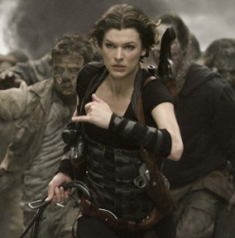RedLab takes on Evil, new workflows

When Toronto-based REDLABdigital landed the 3D finishing work for the latest Resident Evil franchise installment, it faced an interesting dilemma.
While it specializes in Red camera post-production, the new Red Epic cameras used to shoot Evil had only come to market six months prior, and not only that, it was switching from Final Cut to Avid 6 as well. Therefore, a whole new workflow had to be designed in tandem with starting work on a major film.
But, Johnny Megalos, partner and managing director of Toronto’s REDLABdigital, says that the key to REDLAB’s success over the last five years is the company’s ability to quickly adapt new workflows in the post-production pipeline.
Even so, creating a new workflow for Red Epic and Avid while starting on Evil was a risky proposition, Megalos admits.
“Red Epics were essentially just released, within six months [of when shooting started], so there were so many intricate bits and pieces [to designing a workflow],” says Megalos.
RedLabdigital got video editing tool Avid Media Composer 6 just a day before principal photography started on the film, and while that was another curve in the post pipeline, Megalos says he is an Avid 6 convert after using it.
“I would say the big kicker in this is Avid 6,” says Megalos. “We know the Epics look beautiful and we were able to do hair and makeup, camera testing and full DI tests with them, but we didn’t get our hands on Avid 6 until…the day before set-up, which is insanity.”
In the first five days of shooting Evil, there was more than half a million feet of film shot, with an average of one to 1.5 TB of raw footage a day to crunch. (In comparison, over six million feet of film were shot during production of the Lord of the Rings trilogy.) REDLAB turned dailies around in 10 hours – basically overnight.
“[I think] the synergy of how this happened is because we’re essentially a boutique company,” says Megalos. “For a film of this size to come to us, [it was] unproven on this level. They took a big risk, and so did we, and especially with an unproven workflow that’s never been done, we all pulled it off and everybody’s very happy. It’s a pretty huge accomplishment.”
Megalos says scaling workflows is essential to a boutique firm.
“I look at it like Air Canada and Porter. We’re the Porter of post,” he jokes. “We can scale and move as fast as the technology and the client demands.”
The company has five principal partners, and REDLAB is in the final stages of finalizing a partnership with Soho Post, which will be a primarily commercial division, and Alchemy, a 3D VFX design animation division.
Amongst some of their larger pioneering red projects were Pontypool, the first full-length Canadian Red feature to premiere at TIFF, and Shaftesbury’s The Listener, the first Canadian television series shot in Red.
The roster of projects they’ve worked on lately, which include Total Recall, Nazi Hunters and Curious and Unusual Deaths, is a testament to the model of workflow scalability.
Currently, they’re working on Muse’s Bomb Girls and Wango Films’ Dead Before Dawn, the first fully Canadian 3D live-action film, which is also being shot on Red.

 The definitive CDN broadcast and production resource.
The definitive CDN broadcast and production resource.










